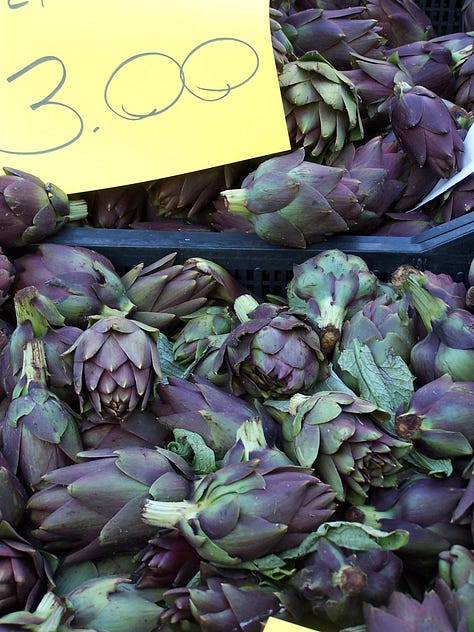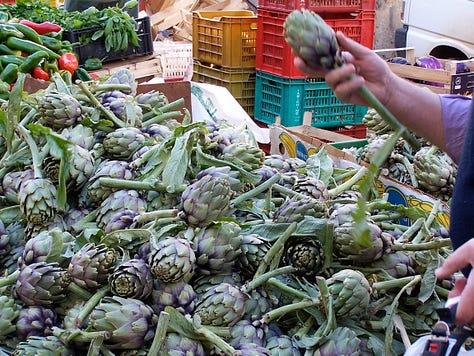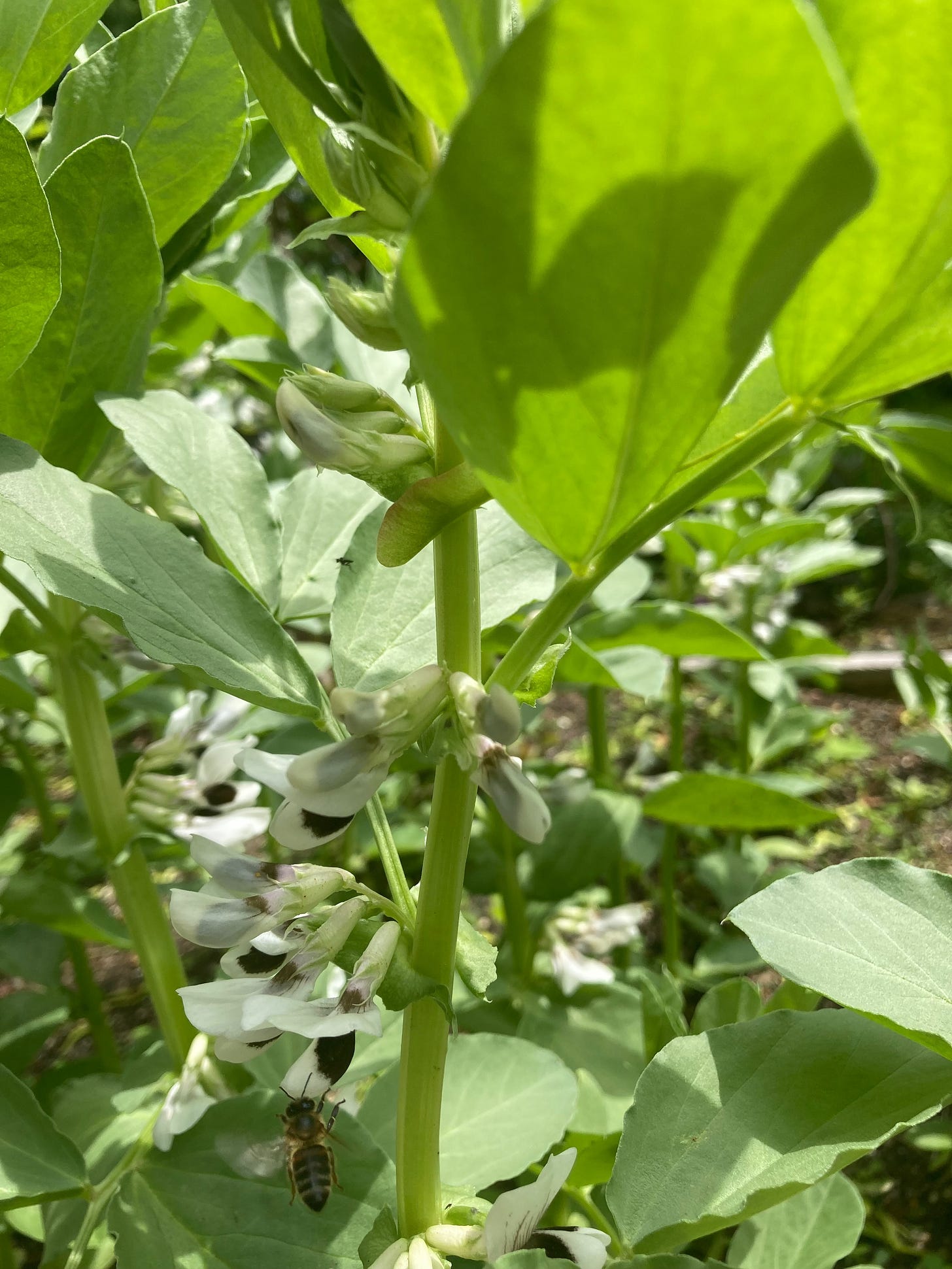If you like this post, please tap on the little heart up there on the lefthand side of the page.
All around the northern rim of the Mediterranean April marks the tail end of artichoke season and the glorious beginning of fava beans. That is reason enough, in any cook’s estimation, for a celebration combining the two in a dish that just goes to show: some sums are greater than their parts. The combination of artichokes and fava beans exists in one form or another from Barcelona to Beirut and back again, sometimes flavored with wild fennel greens, or with mint or dill, or with sweet young peas or fresh asparagus added to the mix, sometimes with the fave pushed aside entirely for peas, asparagus, and artichokes. And why not? With such engaging stars on the scene at the same time, it’s a natural—and simple—way to celebrate the season.
Alas, it’s difficult for American cooks to replicate this dish since most of us simply don’t have access to the quality of artichokes or fave that are taken for granted in Mediterranean markets. But we can try.
In earlier times, fava beans, under their English name broad beans, were standard fare in American home gardens but no longer. Sometime in the late 19th century, they fell out of favor, only to come back very recently as fava beans or fave (the plural, pronounced FAH-vay), their Italian name; they’ve since become the delight of Mediterranean-inspired young chefs who follow religiously the dictum that each individual bean must be peeled separately. Okay, do it if you must and if you have a full kitchen staff at your disposal. But in my own considerable experience, no home cook in any part of the Mediterranean fiddles with peeling bean after bean after bean, no way. I know of no one in the Mediterranean world, whether home cook or restaurant chef (well, maybe just a few ultra-fancy French maîtres cuisiniers) who would bother to peel a fava bean; the belief is this: if the beans are so big that they need peeling, then they’re too big to be eaten fresh. With rare exceptions, the fava beans in U.S. markets, even in farmers’ markets, are exactly that--too big and fat, too mature, too stringy, tough and starchy to mess with. They should be dried on the bean stalk instead and kept for winter storage, as is done in southern Italy or Greece. And as fava season approaches, beg and plead with your farmers to harvest the beans when they’re young and tender.
(I once persuaded the kitchen staff at Chez Panisse to follow a recipe and leave the fava beans unpeeled; they complied but I don’t believe I had a lasting effect on that venerable institution, which continues to this day a haute French tradition, piously peeling each individual fava.)
There is another way to get good tender fava beans, however: Grow your own. It will take more time but they are in fact a dead easy garden vegetable and should be more widely adopted by kitchen gardeners across the country. In some regions where the ground doesn’t freeze hard, the seeds can be thrust four to six inches deep into early winter soil and fresh fava beans will be one of the first spring vegetables to grace the gardener’s table, young, tender, and even ready to eat raw with a wedge of sheep’s milk pecorino cheese—cacio e bacelli, this combination is called in Tuscany where the pecorino used is almost as young and tender as the fave themselves. Try it sometime soon—it’s astonishingly good.
But then there’s the artichoke problem, which may be even more confounding. In any Mediterranean market you’ll find two, three, sometimes even four varieties of artichoke on offer, most of them without any trace of the troublesome choke. That’s the thatchy, scratchy bit at the heart of the plant that reminds us the artichoke is, in essence, an only slightly domesticated thistle. If we Americans are smart enough to put a man on the moon, I ask you, how come we can’t figure out how to make a chokeless artichoke? The Italians, the Spanish, the Greeks have been doing that for centuries. I’m no botanist but I believe the answer lies in methods of cultivation. Artichokes are by nature perennials, and in California, where most American artichokes are grown, the plants are cultivated as perennials, harvesting the same plants, year after year. In much of the Mediterranean, on the other hand, artichokes are replanted each season, using suckers thrown up during the previous season’s growth—daughter plants, in other words, that initially at least, lack the annoying thatch. Could a Castroville entrepreneur repeat that practice? I would be first in line for chokeless artichokes.
In U.S. markets, and probably in other parts of the world as well, artichokes are simply that: Artichokes, without further modifier. In the Mediterranean world, artichokes come in many varieties, throughout a long season that may begin in November and extend even into May. In Italy alone there are, according to one website, Gastronauta, 10 distinct cultivars, and according to another, Dissapore, a full 22. But I know there are many, many more.
Just like olive varieties, just like grapevines, every little niche area of the country has its own specific cultivar, many of which have been granted a DOP (protected denomination of origin) or recognized by Slow Food in the Ark of Taste. And they come in many guises, large or small, spiny or smooth, deep green or dark violet or streaked with color. A person might craft a journey focused on artichokes and travel up and down the Italian peninsula, eating a different artichoke every day.



Combining artichokes with the finest, freshest spring offerings, fava beans, asparagus, sweet green peas grown in the campagna, and tender, slivered spring onions makes vignarola, a traditional Roman spring dish, often prepared with a touch of fresh wild mint called mentuccia or nepitella. Roman cooks might start their vignarola with a handful of diced guanciale (cured pork cheek) or pancetta (salt-cured pork belly, like unsmoked bacon) in a soffrito of garlic and parsley simmered in olive oil, while others may keep the dish strictly vegetarian, relying on the season’s extra-virgin for the necessary fat. The whole is cooked with a splash of white wine from the Castelli Romani, and the juices of all those good things, wine, olive oil, spring vegetables, mingle together to make a seductive presentation that can be, and often is, a main course for supper—vignarola e basta. That’s enough, eaten on its own with crusts of Roman bread to sop up the juices at the end in a process called fare la scarpetta. Though frowned upon elsewhere, among working class Romans la scarpetta is considered perfectly good manners, a salute to the cook’s bravura.
Sicilians make something very similar, la frittella or fritedda and in kitchens all around the Mediterranean, cooks and chefs are busily putting together this freshness and calling it something unique. The recipe that follows is for a dish I had a few years ago on the island of Crete. The Greek name is simple and straightforward, Anginares me Koukia, Artichokes with Broad Beans. Greeks often use wild fennel greens in this; if you have access, by all means substitute wild (or garden) fennel greens for the chopped dill. Just be sure your beans are young and tender—and don’t bother peeling them!
The rest of this post, including the two recipes that follow, is for paid subscribers only. Join now to enjoy the full impact of a Mediterranean spring.
Keep reading with a 7-day free trial
Subscribe to On the Kitchen Porch to keep reading this post and get 7 days of free access to the full post archives.






